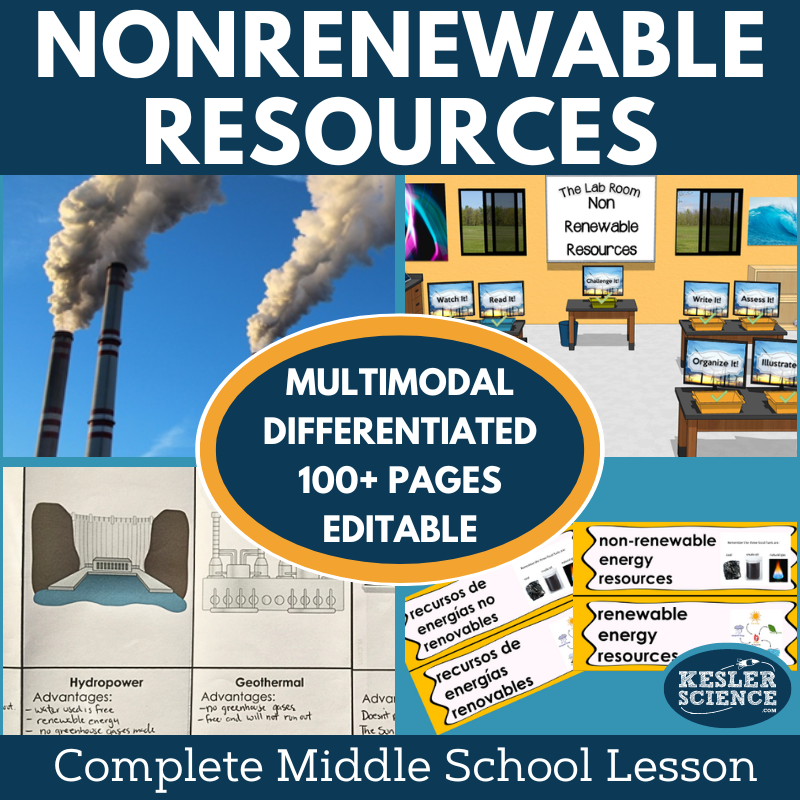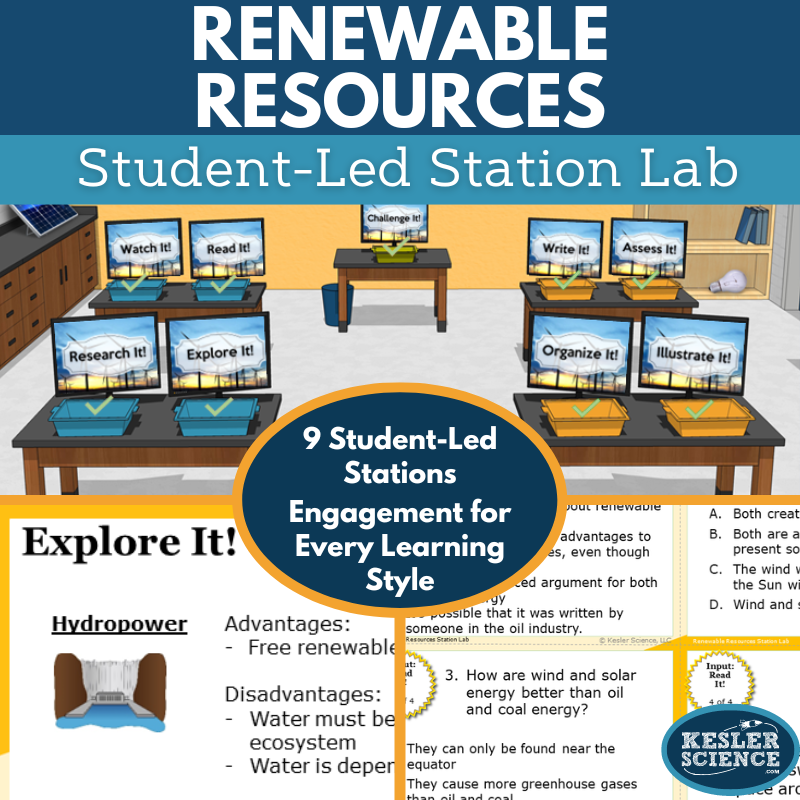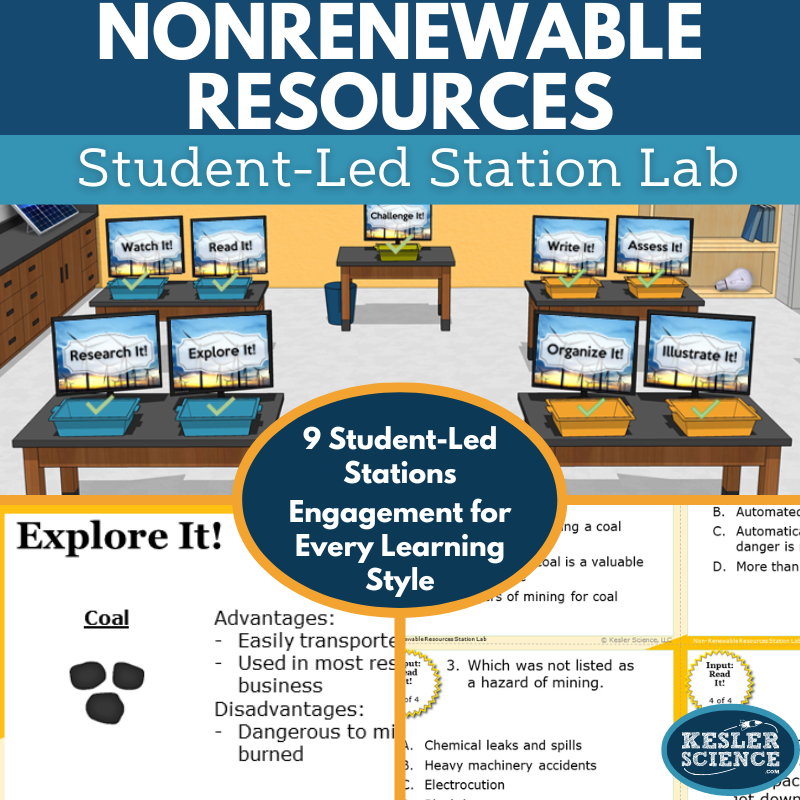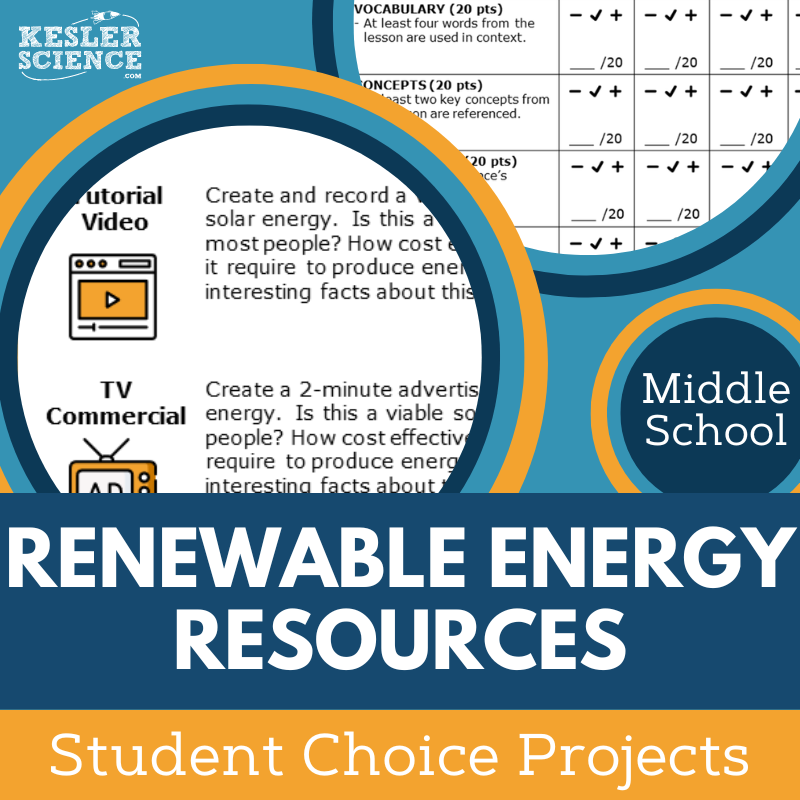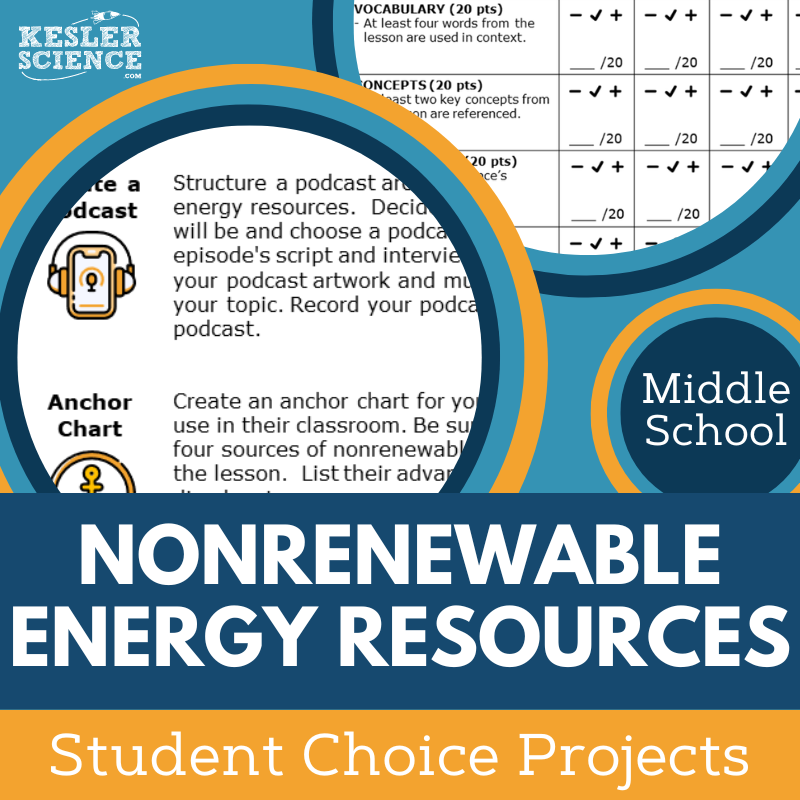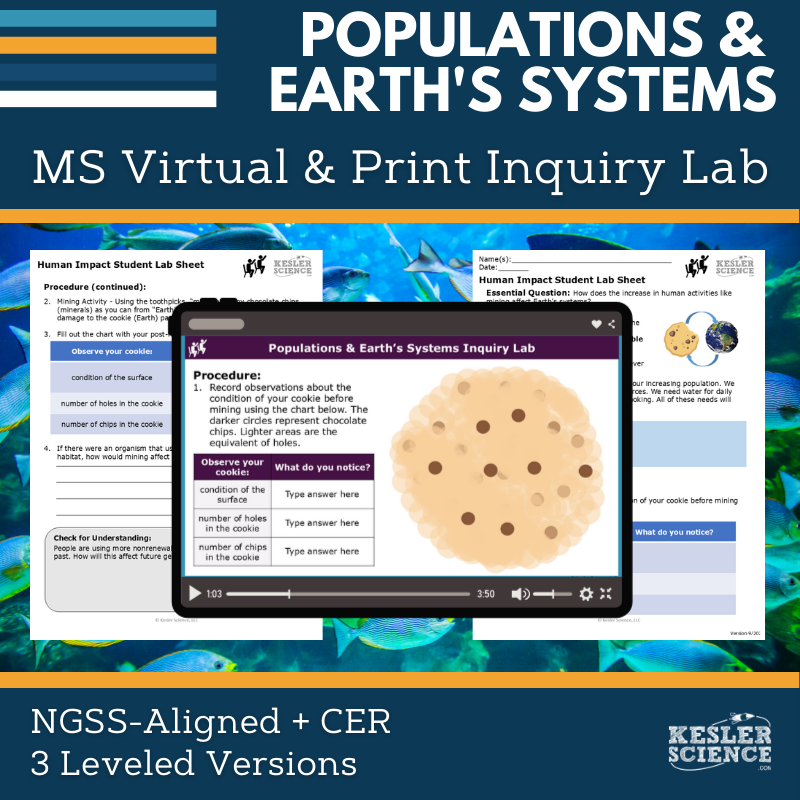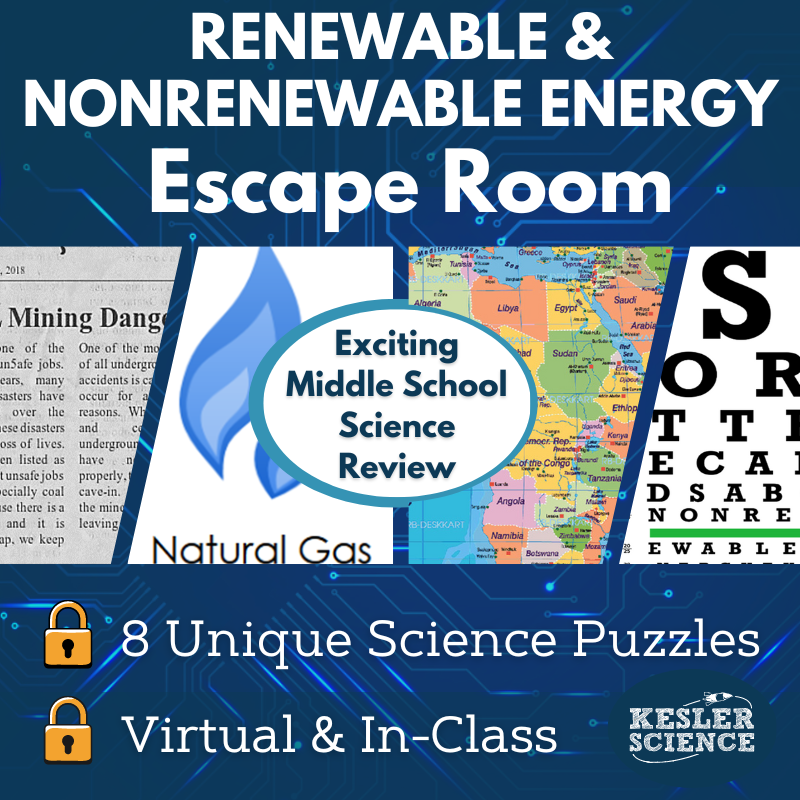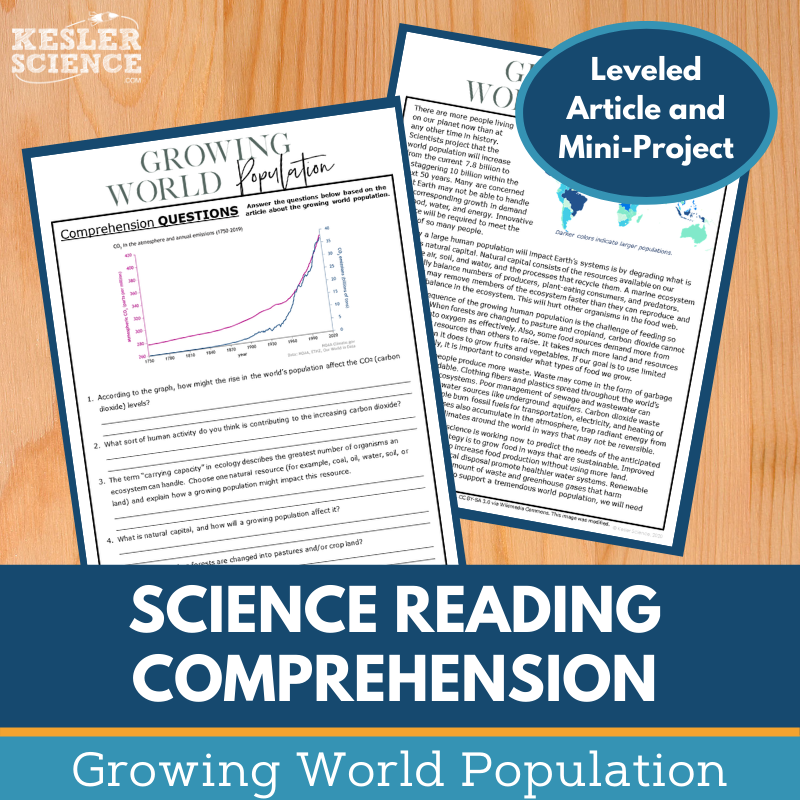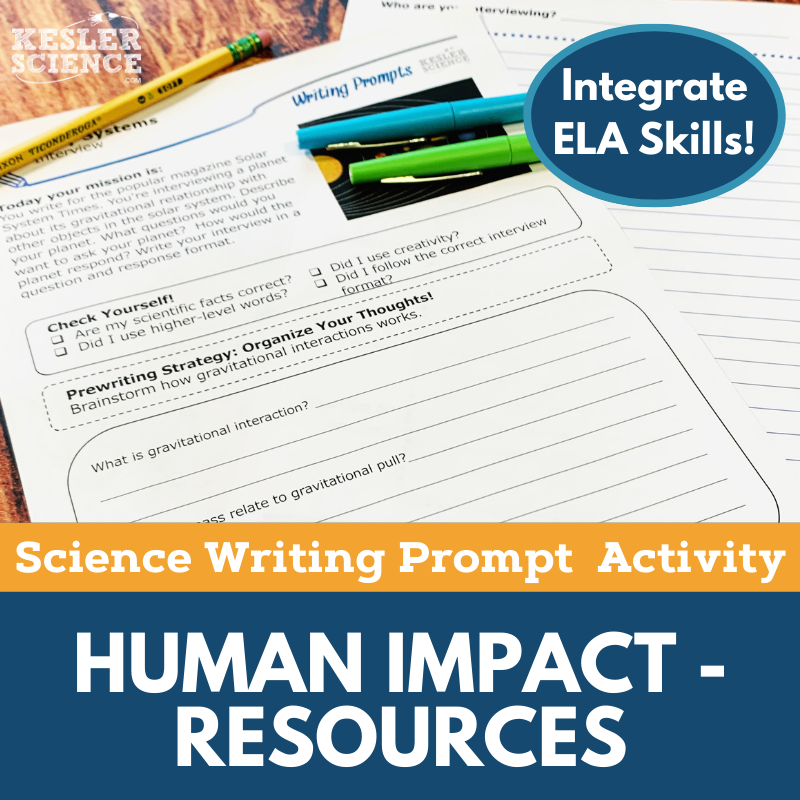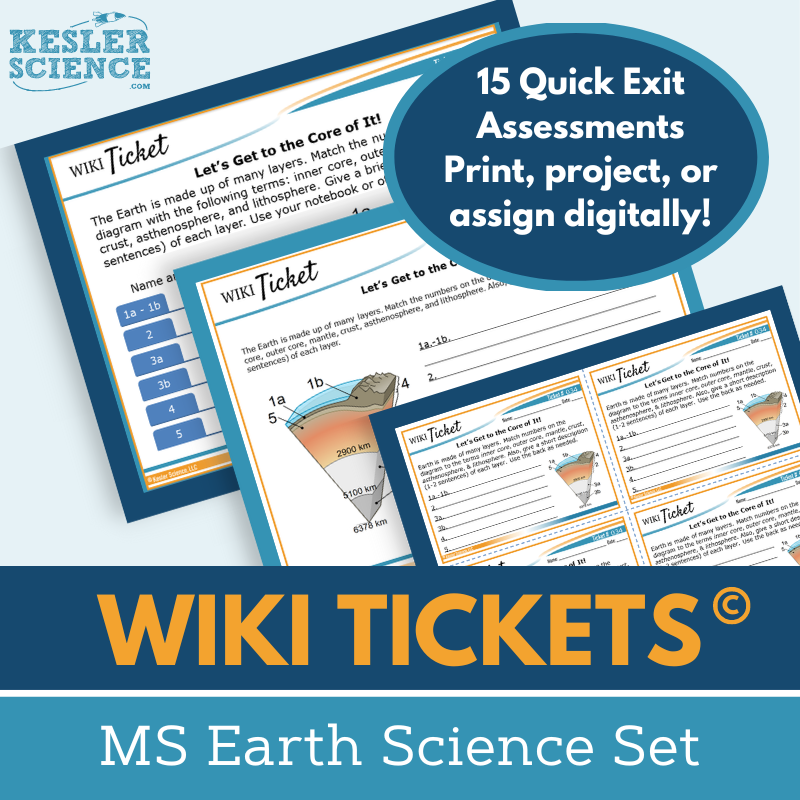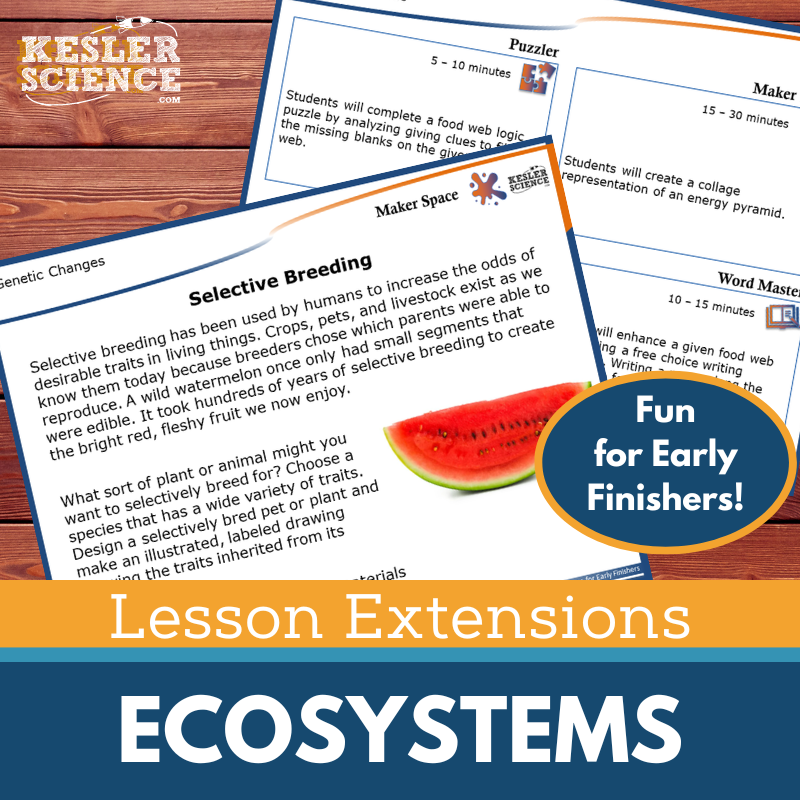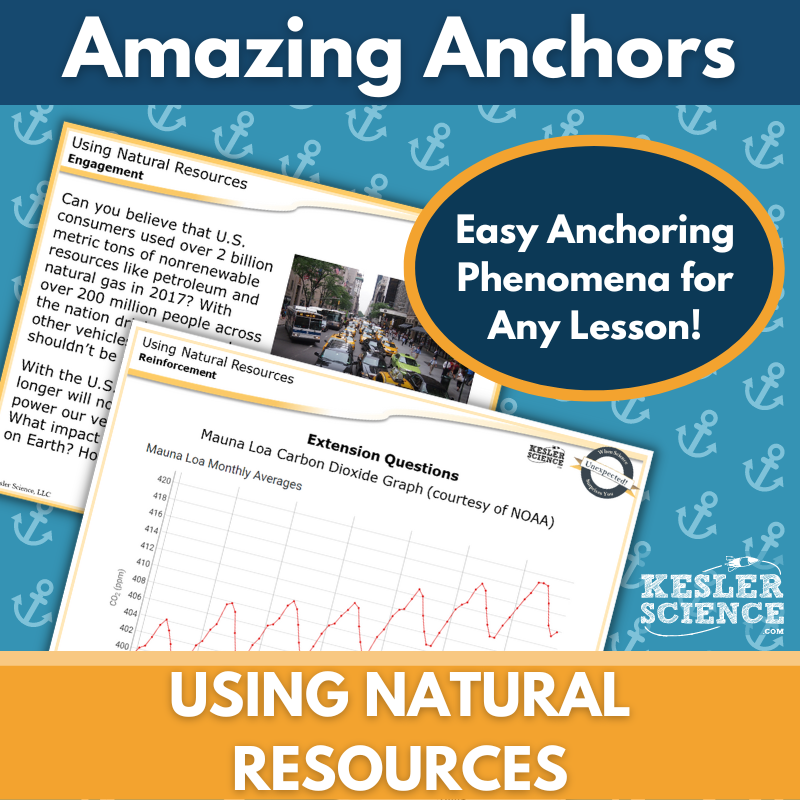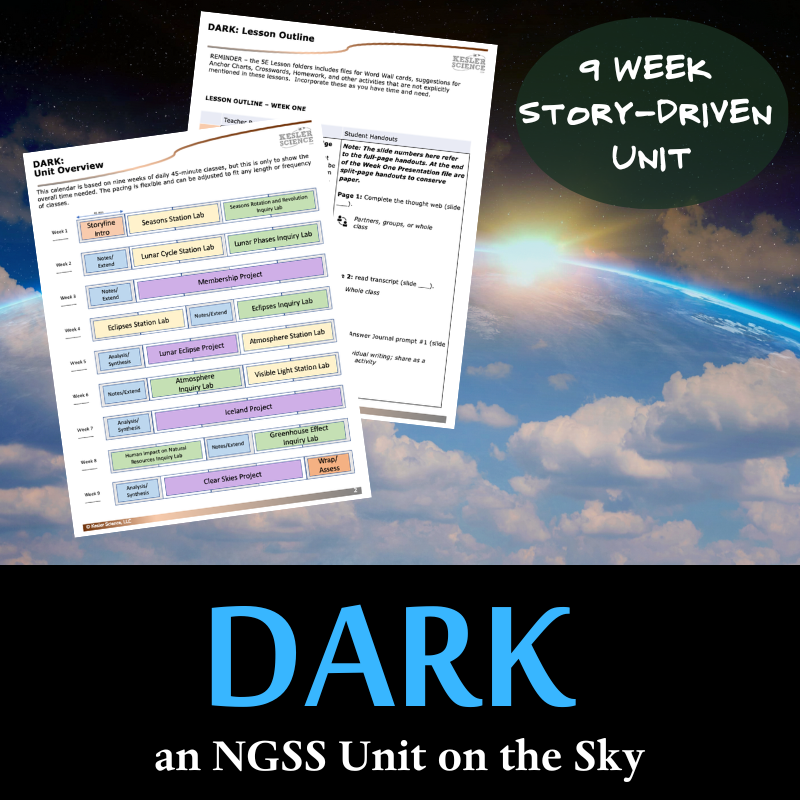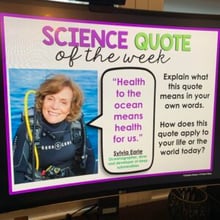Populations & Earth's Systems Activities for Middle School Science
The Renewable and Nonrenewable Resources 5E Lessons engage middle school students in exploring the advantages and disadvantages of energy resources through a structured, student-led approach. The resources below will give students a comprehensive understanding of renewable and nonrenewable resources. All of the following materials are also included in the Kesler Science Membership.
The Kesler Science Renewable Resources 5E Lesson is a comprehensive, student-led unit designed for middle school. It includes editable presentations, worksheets, choice projects, and assessments, requiring minimal prep while allowing for differentiated learning. Students explore the advantages and disadvantages of renewable energy and learn how to present their research in a debate format.
Following the 5E Model, the lesson begins with engaging discussions and activities. The Exploration phase features a differentiated, student-led station lab with nine multimodal stations, including hands-on experiments, reading passages in English and Spanish, research tasks, video discussions, and creative expression activities. Explanation includes editable PowerPoints, interactive notebooks, and note-taking templates. In the Elaboration phase, students complete choice projects, while the Evaluation section provides assessments aligned with STAAR 2.0, including modified versions.
Designed for both in-class and virtual learning, this lesson is flexible and fully adaptable. Spanish translations are provided for vocabulary, reading passages, and interactive notebook pages.
The Kesler Science Renewable Resources 5E Lesson is a comprehensive, student-led unit designed for middle school. It includes editable presentations, worksheets, choice projects, and assessments, requiring minimal prep while allowing for differentiated learning. Students explore the advantages and disadvantages of renewable energy and learn how to present their research in a debate format.
Following the 5E Model, the lesson begins with engaging discussions and activities. The Exploration phase features a differentiated, student-led station lab with nine multimodal stations, including hands-on experiments, reading passages in English and Spanish, research tasks, video discussions, and creative expression activities. Explanation includes editable PowerPoints, interactive notebooks, and note-taking templates. In the Elaboration phase, students complete choice projects, while the Evaluation section provides assessments aligned with STAAR 2.0, including modified versions.
Designed for both in-class and virtual learning, this lesson is flexible and fully adaptable. Spanish translations are provided for vocabulary, reading passages, and interactive notebook pages.
The Kesler Science Nonrenewable Resources 5E Lesson is a comprehensive, student-led unit exploring the advantages and disadvantages of nonrenewable energy resources. Designed for middle school, it includes editable presentations, worksheets, choice projects, and assessments, requiring minimal prep. The lesson aligns with NGSS standards.
Following the 5E Model, students engage through vocabulary activities and class discussions. The exploration phase features a differentiated station lab with multimodal learning, including hands-on experiments, readings in English and Spanish, research tasks, videos, and interactive exercises. Editable PowerPoints, interactive notebooks, and note-taking templates support explanation. Elaboration includes student-choice projects, while evaluation provides assessments aligned with STAAR 2.0, review questions, and discussion worksheets.
The resource is flexible for both digital and printable formats, with Spanish translations for key materials. It is fully adaptable for virtual learning, ensuring accessibility in any classroom setting.
The Kesler Science Nonrenewable Resources 5E Lesson is a comprehensive, student-led unit exploring the advantages and disadvantages of nonrenewable energy resources. Designed for middle school, it includes editable presentations, worksheets, choice projects, and assessments, requiring minimal prep. The lesson aligns with NGSS standards.
Following the 5E Model, students engage through vocabulary activities and class discussions. The exploration phase features a differentiated station lab with multimodal learning, including hands-on experiments, readings in English and Spanish, research tasks, videos, and interactive exercises. Editable PowerPoints, interactive notebooks, and note-taking templates support explanation. Elaboration includes student-choice projects, while evaluation provides assessments aligned with STAAR 2.0, review questions, and discussion worksheets.
The resource is flexible for both digital and printable formats, with Spanish translations for key materials. It is fully adaptable for virtual learning, ensuring accessibility in any classroom setting.
Engage your middle school students in a student-led exploration of renewable resources with this interactive station lab. Designed for in-class or virtual learning, this modular activity encourages students to apply scientific principles to minimize human impact on the environment through nine engaging stations.
Students interact with new concepts through hands-on demonstrations, research, readings, and videos. They then demonstrate their understanding by organizing information, illustrating models, writing responses, and completing assessments. A bonus challenge station offers extension activities for early finishers.
With differentiated resources in English and Spanish, this low-prep, high-engagement lesson supports active learning and critical thinking.
Engage your middle school students in a student-led exploration of renewable resources with this interactive station lab. Designed for in-class or virtual learning, this modular activity encourages students to apply scientific principles to minimize human impact on the environment through nine engaging stations.
Students interact with new concepts through hands-on demonstrations, research, readings, and videos. They then demonstrate their understanding by organizing information, illustrating models, writing responses, and completing assessments. A bonus challenge station offers extension activities for early finishers.
With differentiated resources in English and Spanish, this low-prep, high-engagement lesson supports active learning and critical thinking.
Engage your middle school students in an interactive, student-led station lab exploring nonrenewable resources. Designed for both in-class and virtual learning, this activity allows students to research and discuss the advantages and disadvantages of resource use through nine differentiated stations.
Students encounter new concepts through hands-on demonstrations, research, readings, and videos, while demonstrating their understanding through organizing information, illustrating models, writing responses, and completing assessments. A bonus challenge station provides extension activities for early finishers.
With ready-to-use signage, task cards, and resources, this low-prep, high-engagement lesson encourages independent learning and critical thinking. Differentiated reading passages are available in English and Spanish to support diverse learners.
Engage your middle school students in an interactive, student-led station lab exploring nonrenewable resources. Designed for both in-class and virtual learning, this activity allows students to research and discuss the advantages and disadvantages of resource use through nine differentiated stations.
Students encounter new concepts through hands-on demonstrations, research, readings, and videos, while demonstrating their understanding through organizing information, illustrating models, writing responses, and completing assessments. A bonus challenge station provides extension activities for early finishers.
With ready-to-use signage, task cards, and resources, this low-prep, high-engagement lesson encourages independent learning and critical thinking. Differentiated reading passages are available in English and Spanish to support diverse learners.
The Renewable Resources Student Choice Projects lesson aligns with NGSS standards, allowing middle school students to select a project that suits their preferred output style. A project page outlines six student-led options, plus a “design your own” project, with an editable rubric for teacher, peer, or self-assessment.
These flexible, multimodal projects provide creative ways for students to demonstrate their understanding. Two versions of the project page support differentiation, with modified options for students needing remediation and challenge options for advanced learners. Teachers can adjust the rubric to fit grading needs.
The projects require standard classroom supplies like paper, markers, and scissors, with many options available for digital completion. Some crafting materials may be helpful for building models.
The Renewable Resources Student Choice Projects lesson aligns with NGSS standards, allowing middle school students to select a project that suits their preferred output style. A project page outlines six student-led options, plus a “design your own” project, with an editable rubric for teacher, peer, or self-assessment.
These flexible, multimodal projects provide creative ways for students to demonstrate their understanding. Two versions of the project page support differentiation, with modified options for students needing remediation and challenge options for advanced learners. Teachers can adjust the rubric to fit grading needs.
The projects require standard classroom supplies like paper, markers, and scissors, with many options available for digital completion. Some crafting materials may be helpful for building models.
The Nonrenewable Resources Student Choice Projects lesson aligns with NGSS standards, allowing middle school students to select a project that suits their preferred output style. A project page outlines six student-led options plus a “design your own” project, with an editable rubric for teacher, peer, or self-assessment.
These flexible, multimodal projects provide creative ways for students to demonstrate their understanding. Two versions of the project page support differentiation, with modified options for students needing remediation and challenge options for advanced learners. Teachers can adjust the rubric to fit grading needs.
The projects use standard classroom supplies like paper, markers, and scissors, with many options available for digital completion. Some crafting supplies may be useful for model-building.
The Nonrenewable Resources Student Choice Projects lesson aligns with NGSS standards, allowing middle school students to select a project that suits their preferred output style. A project page outlines six student-led options plus a “design your own” project, with an editable rubric for teacher, peer, or self-assessment.
These flexible, multimodal projects provide creative ways for students to demonstrate their understanding. Two versions of the project page support differentiation, with modified options for students needing remediation and challenge options for advanced learners. Teachers can adjust the rubric to fit grading needs.
The projects use standard classroom supplies like paper, markers, and scissors, with many options available for digital completion. Some crafting supplies may be useful for model-building.
The Populations and Earth's Systems Inquiry Lab aligns with NGSS MS-ESS3-4, helping students construct an argument supported by evidence on how human population growth and resource consumption affect Earth’s systems. This lab engages students through both hands-on and digital interactive activities, allowing flexibility for different classroom needs.
Students investigate human impact on Earth through a cookie mining activity and an included online resource. The lab includes comprehension questions, Claim-Evidence-Reasoning (C.E.R.) prompts, and a reflection section. Differentiation is built in with three levels: a dependent version with guided inquiry, a modified version with structured support, and an independent version for advanced learners.
The print format includes a hands-on experiment where students use simple materials like a chocolate chip cookie and toothpicks. The digital format is an interactive PowerPoint compatible with Google Slides, requiring no physical materials, making it ideal for remote learning or absent students.
Teachers benefit from editable files, answer keys, teacher resource pages, and multimodal learning options to engage middle school students. Whether in print or digital form, this lab offers a flexible, comprehensive approach to exploring human impact on the environment.
The Populations and Earth's Systems Inquiry Lab aligns with NGSS MS-ESS3-4, helping students construct an argument supported by evidence on how human population growth and resource consumption affect Earth’s systems. This lab engages students through both hands-on and digital interactive activities, allowing flexibility for different classroom needs.
Students investigate human impact on Earth through a cookie mining activity and an included online resource. The lab includes comprehension questions, Claim-Evidence-Reasoning (C.E.R.) prompts, and a reflection section. Differentiation is built in with three levels: a dependent version with guided inquiry, a modified version with structured support, and an independent version for advanced learners.
The print format includes a hands-on experiment where students use simple materials like a chocolate chip cookie and toothpicks. The digital format is an interactive PowerPoint compatible with Google Slides, requiring no physical materials, making it ideal for remote learning or absent students.
Teachers benefit from editable files, answer keys, teacher resource pages, and multimodal learning options to engage middle school students. Whether in print or digital form, this lab offers a flexible, comprehensive approach to exploring human impact on the environment.
The Renewable and Nonrenewable Energy Escape Room is an engaging, interactive activity that allows students to demonstrate their understanding of renewable and nonrenewable energy sources. Designed to align with TEKS and NGSS standards, this escape room challenges students to explore the advantages and disadvantages of various energy resources while considering their environmental impact.
Teachers have complete control over the eight independent puzzles, selecting which to use and in what order, making it adaptable for different class lengths. The escape room can be conducted using manila envelopes for an easy setup or with locks and a storage box for a more authentic experience. A digital version is available for online learning via PowerPoint or Google Slides, with a printable version for at-home use.
This resource includes teacher directions, detailed answer keys, a digital answer sheet via Google Forms, video challenges, reward templates, and over 50 prize ideas. With engaging puzzles, printable props, and interactive elements, this escape room provides a memorable and standards-aligned learning experience.
The Renewable and Nonrenewable Energy Escape Room is an engaging, interactive activity that allows students to demonstrate their understanding of renewable and nonrenewable energy sources. Designed to align with TEKS and NGSS standards, this escape room challenges students to explore the advantages and disadvantages of various energy resources while considering their environmental impact.
Teachers have complete control over the eight independent puzzles, selecting which to use and in what order, making it adaptable for different class lengths. The escape room can be conducted using manila envelopes for an easy setup or with locks and a storage box for a more authentic experience. A digital version is available for online learning via PowerPoint or Google Slides, with a printable version for at-home use.
This resource includes teacher directions, detailed answer keys, a digital answer sheet via Google Forms, video challenges, reward templates, and over 50 prize ideas. With engaging puzzles, printable props, and interactive elements, this escape room provides a memorable and standards-aligned learning experience.
This Growing World Population Science Reading Comprehension Lesson explores world population growth through a nonfiction article, comprehension questions, and a graphing activity. Designed for middle school, the leveled passage enhances science literacy and reading comprehension.
The resource includes two Lexile-leveled articles (1100-1300), five to seven comprehension questions, a hands-on mini-project, and a Cornell notes template. Engaging, printable graphics support student learning.
Ideal for sub plans, extra credit, ISS, or whole-class instruction, this resource fosters critical thinking, discussion, and textual analysis. It is compatible with Google Classroom, MS Teams, Schoology, and Canvas, allowing for both in-person and virtual learning.
This Growing World Population Science Reading Comprehension Lesson explores world population growth through a nonfiction article, comprehension questions, and a graphing activity. Designed for middle school, the leveled passage enhances science literacy and reading comprehension.
The resource includes two Lexile-leveled articles (1100-1300), five to seven comprehension questions, a hands-on mini-project, and a Cornell notes template. Engaging, printable graphics support student learning.
Ideal for sub plans, extra credit, ISS, or whole-class instruction, this resource fosters critical thinking, discussion, and textual analysis. It is compatible with Google Classroom, MS Teams, Schoology, and Canvas, allowing for both in-person and virtual learning.
The Human Impact on Resources Science Writing Prompt Activity engages middle school students in a persuasive writing exercise to reinforce their understanding of Earth’s systems. Aligned with NGSS MS-ESS3-4, this activity challenges students to construct evidence-based arguments on how human population growth and resource consumption impact the environment. Designed for both in-person and virtual learning, it supports science reasoning, writing skills, and exploration beyond the classroom.
This resource includes teacher directions with answer guides and rubrics, projection and print-ready handouts, and a digital PowerPoint version compatible with Google Slides. Students receive pre-writing strategies, self-check tools, and layout templates to support their writing process. The activity works well as a cross-curricular project, pre-test assessment, early finisher enrichment, extra credit, make-up work, TELPAS sample, or differentiation tool. Ideal for interactive notebooks or writing journals, this engaging prompt can also be displayed on a bulletin board or compiled into a student anthology. Designed for review, it assumes prior knowledge or access to research materials.
The Human Impact on Resources Science Writing Prompt Activity engages middle school students in a persuasive writing exercise to reinforce their understanding of Earth’s systems. Aligned with NGSS MS-ESS3-4, this activity challenges students to construct evidence-based arguments on how human population growth and resource consumption impact the environment. Designed for both in-person and virtual learning, it supports science reasoning, writing skills, and exploration beyond the classroom.
This resource includes teacher directions with answer guides and rubrics, projection and print-ready handouts, and a digital PowerPoint version compatible with Google Slides. Students receive pre-writing strategies, self-check tools, and layout templates to support their writing process. The activity works well as a cross-curricular project, pre-test assessment, early finisher enrichment, extra credit, make-up work, TELPAS sample, or differentiation tool. Ideal for interactive notebooks or writing journals, this engaging prompt can also be displayed on a bulletin board or compiled into a student anthology. Designed for review, it assumes prior knowledge or access to research materials.
The WIKI Tickets© Earth Science formative assessments provide engaging and flexible ways to check student understanding in 6th-8th grade science. This set includes 15 assessments, each available in five formats: a full-screen projection version, three print handouts, and an interactive digital version compatible with PowerPoint and Google Slides.
Aligned with NGSS and TEKS standards, these assessments cover topics such as ecoregions in Texas, human impact on the environment and natural resources, plate tectonics, the rock cycle, and groundwater resources. Some standards have multiple tickets, and a table of contents file is included for alignment reference.
Designed for both in-person and virtual learning, WIKI Tickets© can be used as exit tickets, bellringers, or quick checks. They can be projected for whole-class responses, printed in various formats, or assigned digitally. These assessments offer a simple, effective way to gauge student progress in earth science.
The WIKI Tickets© Earth Science formative assessments provide engaging and flexible ways to check student understanding in 6th-8th grade science. This set includes 15 assessments, each available in five formats: a full-screen projection version, three print handouts, and an interactive digital version compatible with PowerPoint and Google Slides.
Aligned with NGSS and TEKS standards, these assessments cover topics such as ecoregions in Texas, human impact on the environment and natural resources, plate tectonics, the rock cycle, and groundwater resources. Some standards have multiple tickets, and a table of contents file is included for alignment reference.
Designed for both in-person and virtual learning, WIKI Tickets© can be used as exit tickets, bellringers, or quick checks. They can be projected for whole-class responses, printed in various formats, or assigned digitally. These assessments offer a simple, effective way to gauge student progress in earth science.
Lesson Extensions provide engaging, student-choice activities designed to challenge early finishers and deepen their understanding of ecosystem standards. These activities help fill downtime, reinforce critical thinking, and keep students engaged with rigorous yet enjoyable learning opportunities. Aligned with NGSS and TEKS, they support independent learning and enrichment in ecosystem science.
Each extension includes four interactive components: Puzzler for problem-solving, Maker Space for hands-on STEAM activities, Tech Connection for digital demonstrations, and Word Master for creative writing. With teacher directions, answer keys, and both print and projection versions, these extensions are perfect for lesson wrap-ups, enrichment, or independent challenges, ensuring students remain engaged and learning at a deeper level. Topics covered include biodiversity, biomes, ecological succession, human impact, food webs, photosynthesis, reproduction, and more.
Lesson Extensions provide engaging, student-choice activities designed to challenge early finishers and deepen their understanding of ecosystem standards. These activities help fill downtime, reinforce critical thinking, and keep students engaged with rigorous yet enjoyable learning opportunities. Aligned with NGSS and TEKS, they support independent learning and enrichment in ecosystem science.
Each extension includes four interactive components: Puzzler for problem-solving, Maker Space for hands-on STEAM activities, Tech Connection for digital demonstrations, and Word Master for creative writing. With teacher directions, answer keys, and both print and projection versions, these extensions are perfect for lesson wrap-ups, enrichment, or independent challenges, ensuring students remain engaged and learning at a deeper level. Topics covered include biodiversity, biomes, ecological succession, human impact, food webs, photosynthesis, reproduction, and more.
This Amazing Anchors Phenomenon Lesson introduces the use of natural resources through real-world connections. It begins with an introductory reading on nonrenewable resources in the U.S., accompanied by comprehension and extension questions to prepare students for further learning. An explanatory reading then breaks down the science behind natural resource use, reinforced with additional questions to extend understanding.
Aligned with NGSS standard MS ESS3-4, this no-prep resource includes teacher directions, answer keys, projection slides, and both print and digital formats for Google Classroom and other LMS platforms. A modified version provides sentence starters for student support. Designed to bookend a lesson, these engaging readings serve as supplements to reinforce learning in any in-person or virtual classroom.
This Amazing Anchors Phenomenon Lesson introduces the use of natural resources through real-world connections. It begins with an introductory reading on nonrenewable resources in the U.S., accompanied by comprehension and extension questions to prepare students for further learning. An explanatory reading then breaks down the science behind natural resource use, reinforced with additional questions to extend understanding.
Aligned with NGSS standard MS ESS3-4, this no-prep resource includes teacher directions, answer keys, projection slides, and both print and digital formats for Google Classroom and other LMS platforms. A modified version provides sentence starters for student support. Designed to bookend a lesson, these engaging readings serve as supplements to reinforce learning in any in-person or virtual classroom.
"Explories: DARK" is an NGSS unit that combines a real-world storyline with Kesler Science inquiry labs, station labs, and 5E lessons. Students will join the fictional Amateur Astronomers’ Conservation Society, where they will investigate the Sun, the Moon, and Earth’s relationships and analyze atmospheric changes that impact the future.
This unit provides day-by-day teacher instructions, four unit projects, five station labs, six inquiry labs, and five 5E lessons. It includes student activity pages, project-based and traditional assessments, rubrics for standards-based grading, journaling activities, and two training videos.
Aligned with NGSS standards MS-ESS3-4 and MS-ESS3-5, students will construct evidence-based arguments on the human impact on Earth's systems and explore factors contributing to global temperature rise. Through engaging activities such as modeling celestial relationships, studying eclipses, reducing light pollution, and investigating atmospheric changes, students will experience the sky like never before.
"Explories: DARK" is an NGSS unit that combines a real-world storyline with Kesler Science inquiry labs, station labs, and 5E lessons. Students will join the fictional Amateur Astronomers’ Conservation Society, where they will investigate the Sun, the Moon, and Earth’s relationships and analyze atmospheric changes that impact the future.
This unit provides day-by-day teacher instructions, four unit projects, five station labs, six inquiry labs, and five 5E lessons. It includes student activity pages, project-based and traditional assessments, rubrics for standards-based grading, journaling activities, and two training videos.
Aligned with NGSS standards MS-ESS3-4 and MS-ESS3-5, students will construct evidence-based arguments on the human impact on Earth's systems and explore factors contributing to global temperature rise. Through engaging activities such as modeling celestial relationships, studying eclipses, reducing light pollution, and investigating atmospheric changes, students will experience the sky like never before.
Year-Round Resources
These year-round activities will increase your students' understanding of many middle school science topics. All of these activities are also included in the Kesler Science Membership.
Visual Data & Graphing
You're not alone if your students struggle with understanding graphs, charts, and tables. It's a skill that takes an enormous amount of practice. This resource will help students build a strong foundation in analyzing data and creating their own data visualizations.
Bell Ringers and Warm-Ups
These middle school science bell ringers are an excellent way to engage your students as soon as they walk into your classroom. This comprehensive FULL YEAR resource includes everything you need to start off each science class with an interesting warm-up activity.
Review Board Games
Each game board has been carefully designed to keep students engaged. There are 10 different action spaces on each board and dozens of question cards. All of the actions are related to science concepts and keep the students motivated throughout the game.
Each game is ready to play. Simply print out the board and the cards and let the students enjoy reviewing nine different units.
Essential Questions and Standards
Below are the essential questions and standards associated with the lessons and activities included in the populations and Earth's systems unit. This topic is only one of more than 100 middle school science topics included in the Kesler Science Membership.
-
What are the advantages and disadvantages of renewable energy resources?
-
How can my research findings be presented in a debate form?
-
What are the advantages and disadvantages of nonrenewable energy resources?
-
How can my research findings be presented in a debate format?
-
NGSS - MS-ESS3-4 Populations & Earth's Systems
Kesler Science Membership
Imagine never having to search for another middle school science lesson again. The membership gives you access to ALL of the Kesler Science products in one place (Yes, including everything above).
Say goodbye to long hours of lesson prep.



